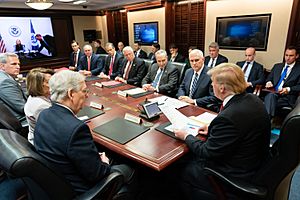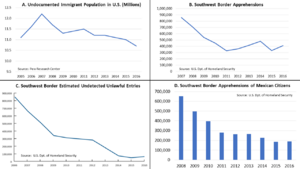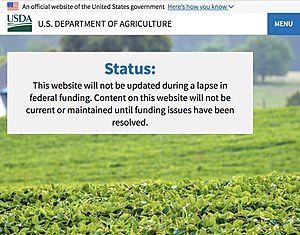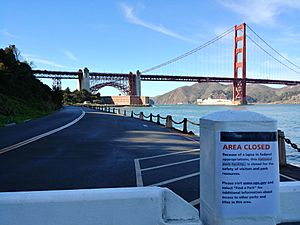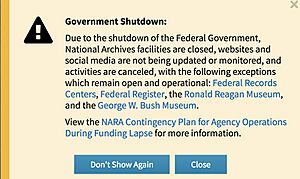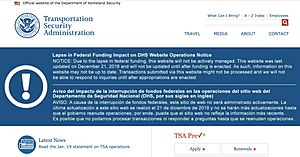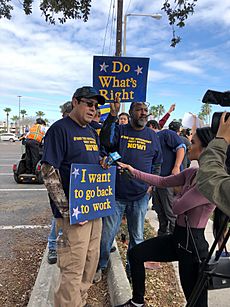2018–2019 United States federal government shutdown facts for kids
The United States government had a partial shutdown from December 22, 2018, to January 25, 2019. This lasted 35 days, making it the longest government shutdown in U.S. history. It happened because the U.S. Congress and President Donald Trump could not agree on a spending bill. This bill was needed to fund parts of the government for the 2019 financial year.
When there is no spending bill, a law called the Antideficiency Act stops many government activities. This meant that nine government departments and about 800,000 employees were affected. Some employees had to stop working without pay, while others had to work without getting paid on time. This shutdown affected about a quarter of all government activities. Experts estimated that the shutdown cost the American economy at least $11 billion.
The main reason for the shutdown was President Trump's demand for $5.7 billion. He wanted this money to build a wall on the border between the U.S. and Mexico. In December 2018, the Senate had passed a spending bill without money for the wall. It looked like this bill would pass easily. However, after some criticism from conservative media, President Trump said he would not sign any bill without wall funding. The House of Representatives then passed a bill with wall funding, but it was blocked in the Senate.
In January 2019, new representatives took office, and Democrats gained control of the House. The House quickly passed the same spending bill that the Senate had approved earlier (which did not include wall funding). For several weeks, President Trump insisted he would veto any bill without wall funding. The Senate leader, Mitch McConnell, blocked any bill that Trump would not support. Democrats and some Republicans wanted to end the shutdown. They argued that holding government workers "hostage" was wrong and that talks should only happen after the government reopened.
On January 25, 2019, President Trump agreed to a temporary bill. This bill reopened the government for three weeks, until February 15. This was meant to allow time for more talks to find a bill everyone could agree on. However, Trump repeated his demand for border wall money. He said he would shut down the government again or declare a national emergency if Congress did not provide the funds by February 15.
During the shutdown, President Trump's approval rating went down. Most Americans did not like the shutdown as a way to negotiate. Many blamed Trump for it. A CBS News poll found that 71% of Americans thought the border wall was "not worth the shutdown." A Washington Post/ABC News poll showed that 53% blamed Trump and Republicans.
On February 15, 2019, President Trump declared a national emergency. He did this to get money for the wall without Congress's approval. This happened after he was not happy with a border bill that both the House and Senate had passed the day before.
Contents
- Why the Shutdown Happened
- The Shutdown Period
- What Happened After
- Effects of the Shutdown
- Reactions to the Shutdown
- See also
Why the Shutdown Happened
President Trump had promised to build a wall along the U.S.–Mexico border during his 2016 election campaign. He said Mexico would pay for it. However, the President of Mexico said no to this idea. In 2018, Trump asked for $18 billion from the U.S. government for about 700 miles of border barrier. Most of this was to replace old fences.
In September 2018, Congress passed some spending bills for the 2019 financial year. These bills covered about 77% of government funding. They also included a temporary funding plan until December 7 for the remaining agencies. On December 6, Congress extended this temporary funding until December 21. This gave more time to talk about Trump's border wall plan.
A Senate committee had suggested $1.6 billion for border security. This included money for about 65 miles of pedestrian fencing. However, this bill was never voted on in the full Senate. The Democratic leader, Chuck Schumer, said Democrats would not support $5.7 billion for the wall. He said their position was $1.6 billion for border security.
How the Shutdown Started
On December 11, President Trump met with Democratic leaders Nancy Pelosi and Chuck Schumer. The meeting was shown on TV. Trump asked them to support $5.7 billion for the border wall. They refused, and a heated argument followed. Trump said, "I am proud to shut down the government for border security... I will be the one to shut [the government] down." Schumer replied, "We shouldn't shut down the government over a dispute." Ten days later, Trump blamed Democrats for the shutdown.
A few days later, news reports said Trump might sign a bill without wall funding. This would have delayed the shutdown until 2019. On December 18, Senate leader Mitch McConnell said the government would not shut down. He said Trump was "flexible" about wall funding.
On December 19, the Senate passed a bill to fund the government until February 8, 2019. House Democrats said they would support it. But on December 20, after facing criticism from conservative media, Trump changed his mind. He said he would not sign any bill without border wall funding. The House then passed a bill with $5 billion for the wall. This bill failed in the Senate. Trump's changing position worried some Senate Republicans.
The Shutdown Period
The shutdown began on December 22. President Trump announced he would stay in Washington, D.C., for Christmas. The meaning of "wall" was a big part of the talks.
Laws and Bills
Before the New Congress
Congress took a break on December 22 for the holidays. Many thought the shutdown would not end until the new Congress started in January. The Senate met briefly on December 27 and December 31. The House also met briefly.
With the New Congress
The new Congress started on January 3, 2019. Democrats now had a majority in the House. One of their first actions was to pass a bill to fund the Department of Homeland Security until February 8. They also passed a package of bills to fund the rest of the government for the year. These bills included $1.3 billion for border security, but no extra money for a border wall.
Starting January 9, the House voted on four more spending bills separately. These bills aimed to reopen specific parts of the government. For example, one bill would fund the Treasury Department, including the IRS. Another would fund the Department of Agriculture, including food stamps. The House passed all these bills.
This strategy was similar to what Republicans did during the 2013 shutdown.
In the Senate
Senate leader Mitch McConnell said the Senate would not vote on the House bills. He said Senate Republicans would only support a bill if President Trump supported it. In January 2019, McConnell and Senate Republicans faced more pressure to end the shutdown. Three Republican Senators called for the shutdown to end. They supported the House's bills. Other Republican Senators also said the shutdown was not working.
On January 16, McConnell blocked the House bills from being voted on in the Senate. He did this three more times.
On January 22, McConnell said the Senate would vote on two different bills to end the shutdown. One bill included Trump's proposal for $5.7 billion for a border wall. The other was a three-week temporary funding bill.
On January 24, the Senate voted on both proposals. The Democratic plan had no money for the wall. The Republican plan included Trump's wall funding and changes to immigration rules. Neither plan got the 60 votes needed to pass. The Trump plan failed 50–47. The Democratic plan failed 52–44.
On January 25, House Democrats prepared a new plan. It would provide $5 billion for border security but no wall construction. However, the shutdown ended that same day.
Talks and Discussions
On January 4, President Trump met with Pelosi and Schumer at the White House. Pelosi and Schumer said the shutdown needed to end. They reported that Trump refused and threatened to keep the government closed for "months or even years." Trump later confirmed he made this threat. He also said he was thinking about declaring a national emergency to use military money for the wall.
Trump gave a speech from the Oval Office on January 8. He said there was a "crisis" at the border that only a $5.7 billion steel wall could fix. He did not offer any new ideas to end the shutdown. After his speech, Schumer and Pelosi spoke for the Democrats. They demanded an end to the shutdown. They said Trump "must stop holding the American people hostage."
January 9 Meeting
Trump met with congressional leaders again on January 9. The meeting lasted only 14 minutes. Trump asked Pelosi, "Will you agree to my wall?" When she said no, Trump said "bye-bye" and left. He later called it "a total waste of time." Schumer said Trump had a "temper tantrum." Trump denied this on Twitter.
After this meeting, no more talks happened between Trump and Democratic leaders. Some Republican senators met to discuss a compromise. They thought about agreeing to wall funding in exchange for help for young immigrants (Dreamers). On January 13, Senator Lindsey Graham suggested a vote to reopen the government while talks continued. Trump rejected this idea.
Trump's Proposal
On January 19, Trump offered a new plan. He proposed a temporary extension of two programs that protect about 700,000 immigrants from deportation. These were Temporary Protected Status (TPS) and Deferred Action for Childhood Arrivals (DACA). In return, he wanted funding for the border wall. These protections would be temporary, with no way for people to become citizens. Trump had previously tried to end these programs. He also started talking about a "barrier" instead of a "wall." He said he wanted "steel barriers in high priority locations."
The Republican bill that followed Trump's proposal was very long. It included big changes to U.S. immigration policy. For example, it would make it much harder for children from Central American countries to ask for asylum in the U.S.
Democrats rejected Trump's proposal. Chuck Schumer called it "one-sided" and "harshly partisan." Nancy Pelosi said the temporary DACA proposal was "unacceptable." Republicans, however, liked Trump's plan.
Other Disagreements
Trump's Threat to Declare a National Emergency
During the shutdown, President Trump often threatened to declare a national emergency. This would allow him to build the wall without Congress's approval. Some of his advisors tried to talk him out of it. Officials even thought about using money meant for hurricane and wildfire relief to fund the wall.
If Trump had declared an emergency, it would likely have led to a long legal battle. Democrats said Trump did not have the power to do this. They argued that presidents cannot use emergency powers to fund a policy goal if Congress has not approved it. Legal experts had different opinions on whether it would be legal, but many agreed it would be an abuse of power.
On January 11, Trump said he was not in a hurry to declare an emergency. He said he would rather see Congress "do its job." But the next day, he again threatened to use emergency powers if Democrats did not "come to their senses."
State of the Union Address
On January 16, Nancy Pelosi sent a letter to Trump. She said the House Chamber would not be available for his State of the Union Address on January 29. She suggested finding another date after the government reopened. This speech had only been delayed or changed twice since 1913. In response, Trump said Pelosi would not be allowed to use military planes for her planned trip to visit U.S. troops overseas.
On January 23, Trump insisted he would give the speech as planned. Pelosi replied that the House would not approve the speech in the Chamber until the shutdown ended. Trump later said he would wait until the shutdown was over to give the speech.
How the Shutdown Ended
On January 25, President Trump announced he would support a three-week funding bill. This bill would reopen the government until February 15. The deal did not include money for a wall. As expected, federal employees would get their missed paychecks. Both the Senate and House quickly passed the bill. Trump signed it the same day, ending the shutdown.
Later, Republican senators voted against a bill to give back pay to federal contractors.
What Happened After
If no new law was passed by February 15, another shutdown would have started. A group of senators and representatives reached a deal on February 11. This deal included $1.375 billion for 55 miles of steel border fencing. On February 13, it was reported that Trump was blocking back pay for federal contractors. Both houses passed the bill on February 14.
On February 15, President Trump signed the spending bill to keep the government open. He also declared a national emergency. He hoped this would give him access to $8 billion for border security.
Effects of the Shutdown
Agencies that were funded by bills passed in September 2018 were not affected. About 380,000 federal employees were sent home without pay. Another 420,000 employees had to work without pay. This meant 800,000 workers were affected out of 2.1 million federal employees. Since only about a quarter of the government was shut down, many people did not fully realize the effects.
Government Agencies Affected
Here are some of the government agencies that were affected:
- Department of State
- Department of the Treasury
- Department of Justice
- Most of the Department of the Interior
- Department of Agriculture
- Department of Commerce
- Department of Housing and Urban Development
- Department of Transportation
- Department of Homeland Security
- Some parts of the Department of Health and Human Services (like the Food and Drug Administration)
- The President's main office
- Most independent agencies
- The Judicial Branch (courts)
Some agencies were not affected, including:
- Department of Defense
- Department of Labor
- Most of the Department of Health and Human Services
- Department of Energy
- Department of Education
- Department of Veterans Affairs
- The District of Columbia government (except courts)
- The U.S. Congress
Impact on Federal Employees
The shutdown affected federal workers across the country. FBI agents, federal prison officers, FDA inspectors, NASA employees, TSA staff, Border Patrol, and Coast Guard members either worked without pay or were sent home.
On January 11, 800,000 workers missed their first paycheck. Federal workers usually get paid for holidays like Christmas and New Year's Day. But the shutdown affected their holiday pay. Some workers looked for other jobs. The government's Office of Personnel Management (OPM) even suggested employees write letters to their landlords or creditors. One letter said, "I am a Federal employee who has recently been furloughed... my income has been severely cut." OPM also suggested trading services like painting for rent.
Many furloughed workers and their families shared their struggles online using "#ShutdownStories." They talked about not being able to pay rent, mortgages, or bills. Many turned to food banks for groceries.
On January 4, it was reported that hundreds of senior Trump administration officials would get a pay raise. This was because of a pay freeze that ended due to the shutdown.
On January 10, the Senate approved a bill to give back pay to furloughed federal employees. The House approved it the next day. President Trump signed it into law on January 16.
Impact on Native Americans
Native American tribes did not receive payments from the U.S. government. These payments were promised in treaties for health clinics, salaries, education, and other services. Native lands are managed by the federal government. Native Americans who get money from oil and gas sales on tribal land did not receive their checks. Roads on tribal land were not plowed, trapping some people in their homes. Food services for 90,000 Native Americans were stopped.
Many Native Americans work for the federal government and lost income. The Indian Health Service (IHS), which serves 2.2 million Native Americans, continued to work without pay. By January 23, IHS started denying care that was not "life threatening."
Impact on the Military
Only the Coast Guard was affected by the shutdown. This is because it is part of the Department of Homeland Security. The Navy, Army, Air Force, and Marine Corps were funded through the Department of Defense, so they were not affected. Coast Guard members did not receive their paychecks on January 15 and 30. They continued to patrol the coastline and carry out missions overseas.
Military schools also lost funding. The Coast Guard Academy had to find ways to pay its professors.
Economic Impact
A report on January 28, 2019, estimated the 35-day shutdown cost the American economy at least $11 billion. This included $3 billion in permanent losses. The Washington D.C. area alone lost $119 million each day. This reduced the region's economy by over $2.8 billion. Food pantries in D.C. and Virginia saw a 10% increase in people needing groceries, mostly federal workers.
Some economists thought a long shutdown could hurt people's confidence in the economy. This could even push the U.S. economy into a recession. The shutdown directly affected almost 3% of the U.S. workforce.
Taxes
As tax season began on January 28, about 46,000 IRS workers were called back to work. This was to make sure tax refunds and returns were processed. These workers handled electronic returns, payments, and other important tasks.
Food Stamps, Inspections, and School Lunches
During the shutdown, 95% of staff for the USDA's Food and Nutrition Services were sent home. The food stamp program (SNAP) had some emergency funds. But if the shutdown continued, 38 million Americans could have lost their food stamps.
The Food and Drug Administration (FDA) oversees most of the U.S. food supply. In early January, the FDA commissioner said food inspections were stopped. By January 14, "high-risk" food inspections started again. Consumer groups warned about food safety issues.
School districts worried about feeding children who relied on federally funded lunch programs. Many schools, especially in poor areas, had to limit food options.
National Parks and Museums
National parks were mostly open but had no staff. Buildings were closed. Some parks stayed open with money from states or charities. Others were completely closed. By the third week, three people had died in national parks.
By January 1, 2019, problems like trash piling up and overflowing toilets were common in parks. Scientists worried about the impact on water and soil quality. Other issues included illegal campsites and damage to property.
Closures or Limited Access
New York kept the Statue of Liberty and Ellis Island open. Arizona and Utah kept Grand Canyon and Zion National Parks open. They provided restrooms and trash collection.
Many places were completely closed. This included Bandelier National Monument in New Mexico and Joshua Tree National Park in California. At Joshua Tree, the lack of staff led to damage to protected trees.
The National Archives and Records Administration closed on December 22, 2018. The Library of Congress and the U.S. Botanic Garden stayed open. The Smithsonian Institution closed all its museums and the National Zoo on January 2, 2019. The National Gallery of Art also closed.
Air Travel and Aviation Workers
On January 11, the Transportation Security Administration (TSA) could not pay its workers. 55% more TSA workers called in sick than in January 2018.
Air traffic controllers were required to work without pay. Their union sued the government. Airline safety inspectors were sent home. This delayed the certification of new airplanes. Many TSA employees called in sick because they needed to find jobs that paid immediately.
As the shutdown continued, unions for pilots, flight attendants, and air traffic controllers said they could not "even calculate the level of risk currently at play."
Impact on Airports
Some airports, like Philadelphia International, collected food donations for federal employees. Other airports, like Miami International, closed terminals to manage with fewer TSA workers.
On January 25, flights to LaGuardia Airport in New York were stopped. This was due to staff shortages from the shutdown. This caused delays at other nearby airports. Soon after, the government reopened.
The shutdown also delayed software updates for the Boeing 737 MAX airplane. This delay may have played a role in a later plane crash.
Courts and Law Enforcement
Court-appointed lawyers for poor defendants worked without pay. The federal court system tried to stay open until January 18, then January 25. If funding ran out, they would operate with very limited services. This caused many delays in court cases. Prisons also had staff shortages, affecting lawyer-client visits.
Investigations and Enforcement
FBI agents reported that many investigations were harmed by the shutdown. They could not pay confidential sources. Some FBI offices did not have Spanish-speaking staff. Agents also lacked funds for joint operations with local police.
Federal law enforcement on Native American land worked without pay.
Homeland Security
The Department of Homeland Security (DHS) had to cancel a trip to the U.S.–Mexico border. DHS also could not inspect immigration facilities. The government's e-Verify system, which checks if employees can work in the U.S., was stopped.
During the shutdown, DHS found many cyberattacks on government websites. These attacks were serious because websites could be taken over.
Other Agencies
Many government websites became unsafe or unreachable. This was because digital certificates were not renewed.
The local government of Washington, D.C., continued to operate. However, its local court system, which is part of the federal judiciary, was partially shut down. This stopped services like marriage licensing.
The shutdown also affected the response to the 2018 Sunda Strait tsunami. The U.S. Embassy in Jakarta could not tweet updates. The U.S. Geological Survey could not provide data.
By January 3, 2019, the Federal Communications Commission (FCC) had stopped most operations. The EPA and Department of Energy's Energy Star website were also unavailable.
The U.S. Patent and Trademark Office (USPTO) almost had to stop patent operations. Even though it funds itself, it needs Congress's approval to spend money.
The Smithsonian Institution had to shorten its 2019 Folklife Festival. This was due to funding delays caused by the shutdown.
Reactions to the Shutdown
Protests and Lawsuits
On January 10, several unions protested the shutdown in Washington, D.C. They wanted to show President Trump how the shutdown was hurting individual workers. Similar protests happened in other cities.
The American Federation of Government Employees sued the Trump administration. They challenged the requirement for workers to work without pay. The National Air Traffic Controllers Association also sued. They said not paying workers violated their rights.
Members of Congress and Their Salaries
Members of Congress continued to receive their salaries during the shutdown. This is because their pay is set by permanent law, not annual spending bills.
Many Senators and Representatives said they would donate or refuse their salaries. For example, Senator Catherine Cortez Masto said she would donate hers to a Nevada charity. By January 17, 2019, 102 members of Congress chose to decline or donate their paychecks.
Help for Federal Employees
During the shutdown, many federal workers used food banks. Many food pantries made it easier for government workers to get food. The Salvation Army provided meals. Chef Jose Andres started a program called #ChefsForFeds to feed federal workers.
Some states, like California, offered unemployment benefits to furloughed employees. Organizations like state Attorney Generals' offices and credit card companies offered help with debt and payments. School districts offered free or reduced lunch options for children of federal employees. Many churches and religious groups also helped federal employees.
Statements from Trump Administration Officials
On January 24, Secretary of Commerce Wilbur Ross said federal workers should borrow money to get by. Critics said his comments were inappropriate, especially since he is very wealthy. Ross also said he "did not understand" why people were going to food banks. President Trump suggested grocery stores would "work along" with the government by giving credit to those without funds.
FBI director Christopher Wray said, "Making some people stay home when they don’t want to, and making others show up without pay, it’s mind-boggling, it’s shortsighted and it’s unfair."
Lara Trump, the President's daughter-in-law, said the shutdown was "a little bit of pain, but it's going to be for the future of our country." Many people criticized her comments as being out of touch.
Public Opinion
In January 2019, a CNN poll found that 56% of people were against a border wall, while 39% supported it. A YouGov poll in December 2018 reported that 51% of people thought Trump was "a lot" to blame for the shutdown. 44% blamed congressional Democrats.
During the shutdown, Trump's approval rating slightly decreased. By mid-January 2019, it was at its lowest point since February 2018. A Washington Post–ABC News poll found that more Americans blamed Trump and Republicans for the shutdown. A CBS News poll found that 70% of Americans did not want a government shutdown over the wall.
See also
 In Spanish: Cierre parcial del Gobierno Federal de los Estados Unidos de 2018-2019 para niños
In Spanish: Cierre parcial del Gobierno Federal de los Estados Unidos de 2018-2019 para niños
- Presidency of Donald Trump
- Donald Trump
- January 2018 United States federal government shutdown


